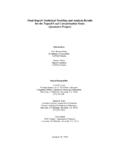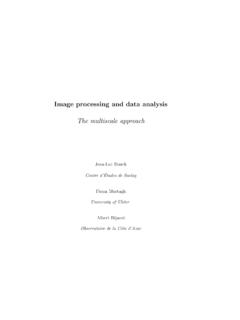Transcription of Variogram Tutorial - Golden Software
1 Variogram Tutorial Golden Software , Inc. 1 Variogram Tutorial Randal Barnes Golden Software , Inc. Variogram Tutorial Golden Software , Inc. 2 Table of Contents 1 Introduction 3 2 What does a Variogram represent? 4 3 What is a Variogram ? 6 4 The Variogram grid 7 5 Modeling the omni-directional Variogram 9 6 Modeling the Variogram anisotropy 12 7 Rules of thumb 15 8 Frequently asked questions 16 9 Some geostatistical references 21 Variogram Tutorial Golden Software , Inc. 3 1 Introduction The Variogram characterizes the spatial continuity or roughness of a data set.
2 Ordinary one-dimensional statistics for two data sets may be nearly identical, but the spatial continuity may be quite different. Refer to Section 2 for a partial justification of the Variogram . Variogram analysis consists of the experimental Variogram calculated from the data and the Variogram model fitted to the data. The experimental Variogram is calculated by averaging one-half the difference squared of the z-values over all pairs of observations with the specified separation distance and direction. It is plotted as a two-dimensional graph. Refer to Section 3 for details about the mathematical formulas used to calculate the experimental Variogram .
3 The Variogram model is chosen from a set of mathematical functions that describe spatial relationships. The appropriate model is chosen by matching the shape of the curve of the experimental Variogram to the shape of the curve of the mathematical function. Refer to the Surfer User's Guide and the topic Variogram Model Graphics in the Surfer Help for graphs illustrating the curve shapes for each function. To account for geometric anisotropy (variable spatial continuity in different directions), separate experimental and model variograms can be calculated for different directions in the data set. Variogram Tutorial Golden Software , Inc.
4 4 2 What does a Variogram represent? Consider two synthetic data sets; we will call them A and B. Some common descriptive statistics for these two data sets are given in Table Table Some common descriptive statistics for the two example data sets. The histograms for these two data sets are given in Figures and According to this evidence the two data sets are almost identical. However, these two data sets are significantly different in ways that are not captured by the common descriptive statistics and histograms. As can be seen by comparing the associated contour plots (see Figures and ), data set A is rougher than data set B.
5 Note that we can not say that data set A is "more variable" than data set B, since the standard deviations for the two data sets are the same, as are the magnitudes of highs and lows. The visually apparent difference between these two data sets is one of texture and not variability. In particular, data set A changes more rapidly in space than does data set B. The continuous high zones (red patches) and continuous low zones (blue patches) are, on the average, smaller for data set A than for data set B. Such differences can have a significant impact on sample design, site characterization, and spatial prediction in general. 0500100015002000250030003500304050607080 90100 110 120130 140 150 160170180 Data ValuesFigure Data Set B Histogram 0500100015002000250030003500304050607080 90100110 120 130 140 150160170180 Data ValuesFrequencyFigure Data Set A Histogram 0255075100125150025507510030405060708090 100110120130140150160 Figure Data Set A Contour Plot 0255075100125150025507510030405060708090 100110120130140150160 Figure Data Set B Contour Plot Variogram Tutorial Golden Software , Inc.
6 5 It is not surprising that the common descriptive statistics and the histograms fail to identify, let alone quantify, the textural difference between these two example data sets. Common descriptive statistics and histograms do not incorporate the spatial locations of data into their defining computations. The Variogram is a quantitative descriptive statistic that can be graphically represented in a manner which characterizes the spatial continuity ( roughness) of a data set. The variograms for these two data sets are shown in Figures and The difference in the initial slope of the curves is apparent. 05101520253035404550 Lag Distance050100150200250300350400450 VariogramDirection: Tolerance: Data Set AFigure Data Set A Variogram and Model 05101520253035404550 Lag Distance050100150200250300350400450 Vari ogramDirection: Tolerance: Data Set BFigure Data Set B Variogram and Model Variogram Tutorial Golden Software , Inc.
7 6 3 What is a Variogram ? The mathematical definition of the Variogram is ( ) where Z(x,y) is the value of the variable of interest at location (x, y), and [ ] is the statisticalexpectation operator. Note that the Variogram , ( ), is a function of the separation between points( x, y), and not a function of the specific location (x, y). This mathematical definition is a useful abstraction, but not easy to apply to observed values. Consider a set of n observed data: {(x1, y1, z1),(x2, y2, z2), .. (xn, yn, zn)}, where (xi,yi) is the location of observation i, and zi is the associated observed value. There are n(n - 1)/2 uniquepairs of observations.
8 For each of these pairs we can calculate the associated separation vector: ( xi,j, yi,j) = (xi-xj, yi-yj) ( ) When we want to infer the Variogram for a particular separation vector, ( x, y), we will use all of the data pairs whose separation vector is approximately equal to this separation of interest: ( xi,j, yi,j) ( x, y) ( ) Let S( x, y) be the set of all such pairs: S( x, y) = { (i,j) | ( xi,j, yi,j) ( x, y) } ( ) Furthermore, let N( x, y) equal the number of pairs in S( x, y). To infer the Variogram from observed data we will then use the formula for the experimental Variogram . ( ) That is, the experimental Variogram for a particular separation vector of interest is calculated by averaging one-half the difference squared of the z-values over all pairs of observations separated by approximately that vector.
9 Variogram Tutorial Golden Software , Inc. 7 4 The Variogram grid If there are n observed data, there are n(n - 1)/2 unique pairs of observations. Thus, even a data set of moderate size generates a large number of pairs. For example, if n = 500, n(n - 1)/2 = 124,745 pairs. The manipulation of such a large number of pairs can be time consuming, even for a fast computer. Surfer pre-computes all of the pairs and stores the necessary sums and differences in the Variogram grid. (Note: a Variogram grid is not the same format as a grid used in creating a map.) To create a new Variogram , choose the Grid | Variogram | New Variogram menu command, specify the data file name in the Open dialog box, and click the Open button.
10 Specify the X, Y, and Z columns, Duplicates settings, Data Exclusion Filter (if any), and review the Data Statistics. Figure Choose the Grid | Variogram | New Variogram menu to display the Data tab of the New Variogram dialog box. Click the General tab to view the Variogram Grid and Detrending options. The Max Lag Distance is the maximum separation distance to be considered during Variogram modeling. By default, this is approximately one-third the diagonal extent of the observed data. The Angular divisions of 180 and the Radial divisions of 100 are adequate for almost any setting. The Detrend options offer advanced data handling options for universal kriging.







